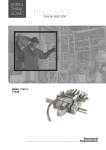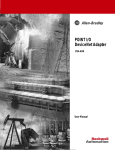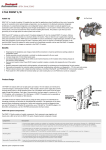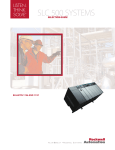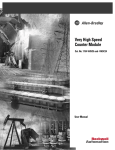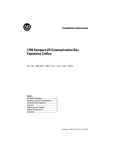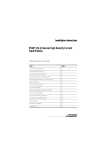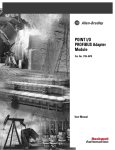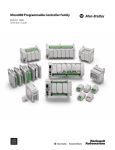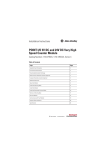Download Select POINT I/O Modules
Transcript
POINT I/O SELECTION GUIDE 1734 AND 1734D SERIES 2 POINT I/O Family The POINT I/O family has modular I/O modules that are ideal for applications where flexibility and low-cost of ownership are key for successful control system design and operation. As a key element in the Rockwell Automation Integrated Architecture, its comprehensive diagnostics and configurable features allow the product to be easily applied to any automation system and reduce engineering costs through standardization. It can be used in remote device panels, local control panels, and can be accessed from many locations including the Internet. This product has just-whatyou-need granularity in 1 to 8 points to reduce system cost and size. The POINT I/O System POINT I/O has 4 major components: y I/O modules provide the field interface and system-interface circuitry y Communication interface modules provide the network-interface circuitry y Terminal base units provide the wiring and signal termination for field-side connections and system power for the backplane y Power distribution modules provide the expandability of the POINT I/O system and the flexibility to mix a variety of signal types Publication 1734-SG001C-EN-P — May 2006 3 1734 POINT I/O modules offer 1 to 8 points per module. The I/O modules are interfaced to a network through a communication interface, which includes a built-in power supply that converts incoming 24V dc power to 5V dc backplane power. Each type of communication interface supports a maximum of 13 to 17 I/O modules, with a maximum of 10 A field power. The I/O modules receive power from the power supply through the backplane. You can expand a POINT I/O assembly up to a maximum of 63 I/O modules or 504 channels. 1734D Series POINTBlock I/O provides a DeviceNet communication interface with up to 16 integrated I/O points in a single module. You can add up to 13 POINT I/O modules to a POINTBlock I/O assembly, for a maximum of 120 channels per assembly. POINT I/O Features y Highly modular design (1 to 8 point modularity) y Broad application coverage y Channel-level diagnostics (LED indicator and electronic) y Channel-level alarm and annunciation (electronic) y Parameter-level explicit messaging y Removal and insertion under power (RIUP) y Network solutions with multiple DeviceNet interfaces, ControlNet, EtherNet/IP, and PROFIBUS DP adapters y Channel-level open-wire detection with electronic feedback y Vertical mounting without derating y 5 g vibration y Channel-level short-circuit detection with electronic feedback y Flash upgradable adapters y Electronic and mechanical keying y Robust backplane design y Hot swapping of I/O modules y Built-in DIN-rail grounding y Mounting base provides continuous backplane and field bus power y Color-coded module labels y UL, C-UL, CE, C-Tick, DeviceNet, EEx certifications (as marked) y Highly reliable structural integrity y Optical isolation between field and system circuits Publication 1734-SG001C-EN-P — May 2006 4 The following chart illustrates the compatibility of POINT I/O with other control platforms, especially within Rockwell Automation. POINT I/O Product Compatibility PLC-5 with Network Port SLC 5/SLC 500 with Network Port PLC-5 Processor via Network Module 1756 Logix Communication Interface PanelView Terminal RSLinx Software 1769-L20, -L30 Controller with 1761-NET Interface 1769-L35E SoftLogix 5800 PC with RSLinx Only 1734-PDN 1734D 1734-ADN(X) 1734-ACNR 1734-AENT 1734-APB IOD IOD IOD NS NS NA IOD IOD IOD NS NS NA IOD IOD IOD NS NS 3 IOD IOD IOD IOD IOD 3 NA NA NA NA NA NA NA NA NA NA NA NA NA NA NA NS NS NA NA IOD NA IOD NA IOD NA IOD IOD IOD NA IOD NS NS NS NS NS NA IOD = I/O Data NS = Not Supported NA = Not Applicable 3 = Requires third party scanner module For information regarding POINT I/O on different networks, please refer to the Selecting a Network Interface section in this document. Publication 1734-SG001C-EN-P — May 2006 5 Communication Considerations POINT I/O features are impacted by your network choice. Network Impact Each POINT I/O module will count as a node on the main DeviceNet network. DeviceNet 1734-PDN or 1734D POINTBlock I/O Total POINTBus backplane current of I/O modules cannot exceed 1.3 A for the 1734-PDN or 1.0 A for a 1734D module. Expansion power supplies may not be used. The 1734-ADNX expansion network port allows for a DeviceNet subnet. DeviceNet 1734-ADN(X) A total of 63 POINT I/O modules can be assembled on a single DeviceNet node. Expansion power supplies may be used to provide additional POINTBus backplane current. A total of 63 POINT I/O modules can be assembled on a single ControlNet node. ControlNet 1734-ACNR Expansion power supplies may be used to provide additional POINTBus backplane current. Up to 25 direct connections and 5 rack connections are allowed. A total of 63 POINT I/O modules can be assembled on a single EtherNet/IP node. EtherNet/IP 1734-AENT Expansion power supplies may be used to provide additional POINTBus backplane current. Refer to the User Manual to determine the ratings for direct and rack connections allowed. A total of 63 POINT I/O modules can be assembled on a single PROFIBUS DP node. PROFIBUS DP 1734-APB Expansion power supplies may be used to provide additional POINTBus backplane current. Publication 1734-SG001C-EN-P — May 2006 6 Specify a POINT I/O System Follow these steps as you specify your POINT I/O system: 9 Step Remember to Select 1 Select a communication interface y the appropriate interface module Choose the interface module for your operating system. y a communication interface that meets the power requirements of your system 2 Select I/O devices based on field devices y location of the device y number of points needed y appropriate catalog number y I/O modules - some have diagnostic features, electronic fusing, isolated inputs/outputs, and unique configurable features y number of points available per module y number of modules 3 Select a wiring base assembly Choose the appropriate wiring base assembly with removable terminal block for your modules. 4 Select optional power components Choose optional components to extend backplane power or change the field power distribution source. 5 Select optional accessories y the appropriate wiring base assembly y additional power components as necessary y adequate power capacity to meet I/O module backplane current requirements y the marker kit, if necessary Choose the marker kit as necessary. 6 Determine mounting requirement Determine needed dimensions based on the communication interface chosen. Publication 1734-SG001C-EN-P — May 2006 y the appropriate number of DINrails based on the number of modules and the physical locations of those modules y horizontal or vertical mounting with no thermal derating 7 Step 1 - Select: y a communication interface module Select POINT I/O Communication Interfaces Separate communication interface adapters are available for different networks. Install adapters into the POINTBus backplane to allow POINT I/O modules to communicate with a controller. NetLinx Architecture NetLinx open network architecture is the Rockwell Automation strategy of using open networking technology for seamless, top-floor to shop-floor integration. The networks in the NetLinx architecture ⎯ DeviceNet, ControlNet, and EtherNet/IP ⎯ speak a common language and share a universal set of communication services. NetLinx architecture, part of the Integrated Architecture, seamlessly integrates all the components in an automation system from a few devices on one network to multiple devices on multiple networks including access to the Internet ⎯ helping you to improve flexibility, reduce installation costs, and increase productivity. y The EtherNet/IP network is an open industrial standard that supports implicit and explicit messaging and uses commercial, off-the-shelf Ethernet equipment and physical media. y The ControlNet network allows intelligent, high-speed control devices to share the information required for supervisory control, work-cell coordination, operator interface, remote device configuration, programming, and troubleshooting. y The DeviceNet network offers high-speed access to plant-floor data from a broad range of plant-floor devices and a significant reduction in wiring. Publication 1734-SG001C-EN-P — May 2006 8 Select a Network You can configure your system for information exchange between a range of devices and computing platforms and operating systems. Application Requirements Network Select y Plant management (material handling) y Configuration, data collection, and control on a single, high-speed network y Time-critical applications with no established schedule y Data sent regularly y Internet/Intranet connection EtherNet/IP 1734-AENT y High-speed transfer of time-critical data between controllers and I/O devices y Deterministic and repeatable data delivery y Media redundancy y Controller redundancy y Intrinsic safety y Redundant controller systems ControlNet 1734-ACNR y Connections of low-level devices directly to plant-floor controllers, without interfacing them y Data sent as needed y More diagnostics for improved data collection and fault detection y Less wiring and reduced start-up time than a traditional, hard-wired system DeviceNet 1734-PDN 1734D 1734-ADN(X) y Connecting to an existing PROFIBUS DP 5 m (16.4 ft) bus, PROFIBUS 12 MB network Publication 1734-SG001C-EN-P — May 2006 1734-APB 9 About the ControlNet Network The 1734-ACNR adapter provides high-speed transfer of time critical data between controllers and I/O devices. It manages data transfers between controllers on the ControlNet network and POINT I/O modules plugged into the POINTBus backplane. The ControlNet network, a communication architecture, allows the exchange of messages between ControlNet products compliant with the ControlNet International specification. The 1734-ACNR adapter features include a variety of control system solutions, local communication network access through the network access port (NAP), and redundant media. It requires Series C POINT I/O modules or later. The 1734-ACNR adapter requires a typical 24V dc power supply with a maximum of 10.2 W of power. It provides a maximum backplane current of 1.0 A @ 5V dc. Backplane current can be extended beyond 1.0 A with a 1734-EP24DC backplane extension power supply. The 1734-EP24DC can supply up to an additional 1.3 A of backplane current. Multiple 1734-EP24DC power supplies can be used to reach the maximum limit of 63 POINT I/O modules if 25 or fewer of these modules are analog or specialty modules. The adapter supports 25 direct and 5 rack I/O connections to the POINT I/O modules. From a single 1734-ACNR adapter, multiple controllers establish I/O connections, up to a maximum of 5 rack I/O connections per adapter. Direct connections must be used with analog and specialty modules. Multiple rack connections permit multiple controllers to connect to I/O over a single 1734-ACNR adapter. The number of connections that can be supported on a network depends on the ControlNet parameters (NUT, RPI, and API) and the POINT I/O configuration by itself (number and types of I/O modules). The following example shows a single POINT I/O ControlNet adapter with 5 connections and 8 I/O modules. The POINT I/O modules are monitored by the 5 controllers on the ControlNet network. The POINT I/O modules in: y slots 1, 3, and 5 are controlled by the first controller. y slots 2 and 4 by the second controller. y slot 6 by the third controller. y slot 7 by the fourth controller. y slot 8 by the fifth controller. Publication 1734-SG001C-EN-P — May 2006 10 When using I/O modules with large amounts of data, it is important to be aware of the 1734-ACNR adapter's data capability. The 1734-ACNR adapter has 586 bytes of memory available for scheduled transmit data. When developing an application, the amount of data used by an individual connection must also include a small amount of overhead (I/O bytes per connection). The following formula tracks the amount of available scheduled transmit data. Available Memory = 586 - [(Number of connections * 10) + Sum of all connection sizes] In the following example, the system uses a 1734-ACNR adapter with five 1734-232ASC modules. Application Data Size (number of bytes) Memory Required 1734-232ASC - 1 100 110 1734-232ASC - 2 88 98 1734-232ASC - 3 96 106 1734-232ASC - 4 96 106 1734-232ASC - 5 92 102 Total Bytes Used 472 522 In this example, a sixth module could be added if it used less than 54 bytes of application data. There are 64 bytes of memory left. 64 = 586 - [(5 * 10) +472] For more information about the 1734-ACNR adapter, see the POINT I/O ControlNet Adapter User Manual, publication 1734-UM008. Publication 1734-SG001C-EN-P — May 2006 11 Select the DeviceNet Communication Interface The POINT I/O family offers four interfaces for connecting to the DeviceNet network. Refer to the following table. For These Features Remember Select y Cost-effective y Electrically connects the main network to the I/O modules, which are connected on the POINTBus backplane 1734-PDN y Each I/O module counts toward the allowable limit of 63 nodes on the main network y No configuration to the 1734-PDN communication interface necessary since it is transparent to the main network y Each POINT I/O module on the main network counts as a separate node. y Network distance limitations. y Acts like a 1734-PDN communication interface, but uses a DeviceNet node number for the y A POINT I/O expansion power supply is not permitted. built-in 8 inputs and 8 outputs y Appears to the main network as a 1734-PDN communication interface with a single, 16-point 1734D Series module attached y Any of the I/O modules may be attached in the same manner they are added to a 1734-PDN communication interface y Behaves as a slave device on the main network and a master on the POINTBus backplane y Allows a group of I/O modules on the subnet to act as a single node on the main network y RSNetWorx for DeviceNet software is needed for configuration of the 1734-ADN adapter on the main network and the POINTBus backplane y Configuration on the POINTBus backplane consists of a scan list that is very similar to those used in all of the DeviceNet master scanner modules y All POINT I/O modules count as a single node on the main network. y The main network distance is acceptable. y POINT I/O expansion power supplies are permitted to add more POINT I/O modules. y Acts like a 1734-ADN adapter, with additional capabilities y Has a second, Phoenix-style connector that extends the subnet off the module, so that any DeviceNet-capable device could be connected to a subnet and scanned by the 1734-ADNX adapter y Node numbers of the devices on the POINTBus backplane and subnet would not count against the 63 slave nodes allowed on the main network y Data from these devices would be included in the data being sent to/from the 1734-ADNX adapter on the main network y Network on the second connector is electrically isolated from the main network and can be used to extend the total DeviceNet trunk line distance For example: with thick round media at 125 Kbps, you could run a maximum of 500 m (1640 ft) to a 1734-ADNX adapter on the main network. You could then wire an additional 500 m (1640 ft) of cable on the subnet connector and double the distance of the network. Remember that this subnet needs terminating resistors and a 24V dc power connection, the same as any other DeviceNet network. y All POINT I/O modules, and some third-party field devices, count as a single node on the main network. y Devices on the subnet and the main network need to be connected at different communication rates or use different sampling methods (for example, change-of-state or polled). 1734-ADNX y The main network distance is not acceptable and additional distance is required. y An expansion power supply may be required to add more modules. y POINT I/O expansion power supplies are permitted. 1734-ADN Publication 1734-SG001C-EN-P — May 2006 12 With the introduction of the 1734-232ASC module, the amount of data to be transferred over the subnet could become substantial. This could also occur with the 1734-ADNX adapter and the standard DeviceNet devices connected to its subnet connector. It is important that the total amount of data coming from the subnet does not exceed the data capability of either the 1734-ADN or 1734-ADNX adapter. y 250 bytes (248 data + 2 bytes command info) for output data (used as either COS, cyclic, or poll) y 250 bytes (248 data + 2 bytes status info) for polled input data y 250 bytes (248 data + 2 bytes status info) for COS/cyclic input data y 8 bytes (6 data + 2 status info) for strobe input data The data coming through the 1734 adapter combined with the other data from the main network cannot exceed the data capability of the main network master scanner. If this occurs, you will need multiple master scanners on the main network and the I/O modules on the subnet will need to be split between multiple 1734-ADN or 1734ADNX adapters. With the 1734-PDN communication interface, the multiple masters on the main network will be able to communicate to separate groups of modules on its subnet through the same 1734-PDN communication interface, so no additional adapter would be necessary. Publication 1734-SG001C-EN-P — May 2006 13 About the EtherNet I/P Network The 1734-AENT adapter supports direct- and rack-optimized connections. A direct connection is a real-time data transfer link between the controller and whatever module occupies the slot that the configuration data references. Direct-connection messaging occurs at a cyclic rate specified by the requested packet interval (RPI) during configuration. A rack-optimized connection is a grouping of data from more than one I/O module into a single block of data sent over a single connection at the same data rate. Rack-optimized connections reduce the total number of connections needed to transfer data when using many I/O modules in a system. Assume a system contains 8 digital I/O modules interfaced to a 1734-AENT adapter. If you used direct connections to transfer data to each of these modules, you need 8 connections ⎯ one to each of the 8 I/O modules. If you use a rack-optimized connection to transfer the data, you need only a single connection ⎯ the connection to the 1734-AENT adapter. Publication 1734-SG001C-EN-P — May 2006 14 About the 1734D Series The 1734D series is a set of DIN-rail mounted products with an integrated DeviceNet communication interface, various combinations of onboard I/O points, removable terminations, and a POINTBus expansion port. The DeviceNet interface presents the integrated I/O as a single DeviceNet node while expansion I/O modules will appear as separate nodes. The 1734D series includes a nonisolated DeviceNet communication interface. The 24V dc from the DeviceNet connection powers a nonisolated dc/dc converter that generates +5V dc. This +5V dc powers the 1734D series electronics and connects to the PointBus port to power the expansion I/O electronics. Connect whatever field power you supply to the internal field-power bus. For example, if 120V ac is applied to the power connections, there will be 120V ac applied to the modules through the internal field-power bus. POINT I/O modules to the right of the 1734D products will also have that internal power bus voltage applied, unless you use a 1734-FPD to interrupt and change the field power-bus voltage. Publication 1734-SG001C-EN-P — May 2006 15 POINTBlock I/O Typical Wiring Some POINT I/O modules are isolated from the field bus power. Be sure to check the I/O module wiring diagram and user manual to determine actual power source wiring requirements. Cat. No.✶ 1734D-IA16(S) 1734D-IB16(S) 1734D-IB8XOB8E(S) 1734D-IB8XOW8(S) 1734D-IA8XOA8(S) 1734D-IA8XOW8(S) Description 120V ac 16 Input Module, Cage-clamp 12/24V dc 16 Input Module, Cage-clamp 24V dc 8 Input/8 Output Module, Cage-clamp 24V dc 8 Input/8 N.O. Relay Module, Cage-clamp 120V ac 8 Input/8 Output Module 120V ac 8 Input/8 N.O. Relay Module, Cage-clamp ✶Catalog numbers ending in S indicate the spring-clamp style. Publication 1734-SG001C-EN-P — May 2006 16 Step 2 - Select: y I/O modules - some modules have diagnostic features, electronic fusing, or individually isolated inputs/outputs Select POINT I/O Modules The POINT I/O family provides a wide range of input and output modules to span many applications, from high-speed digital to process control. POINT I/O modules support producer/consumer technology, which allows input information and output status to be shared among multiple Logix controllers. Each POINT I/O module mounts adjacent to the network adapter or another I/O module and removable terminal block (RTB) to connect all field-side wiring. The RTBs are part of the terminal base assembly (1734-TB, 1734-TB3, 1734-TBS, 1734TB3S, 1734-TBCJC). They are not included with the I/O modules and must be ordered separately. The POINT family of I/O modules includes: y 1734 digital I/O modules. y 1734 analog I/O modules. y 1734 specialty I/O modules. y 1734 wiring systems. y 1734 network communication adapters. Publication 1734-SG001C-EN-P — May 2006 17 Digital I/O Modules Choose digital I/O modules when you need: y Input modules. An input module responds to an input signal in the following manner: - Input filtering limits the effect of voltage transients caused by contact bounce and/or electrical noise. If not filtered, voltage transients could produce false data. All input modules use input filtering. - Optical isolation shields logic circuits from possible damage due to electrical transients. - Logic circuits process the signal. - An input LED indicator turns on or off indicating the status of the corresponding input device. y Output modules. An output module controls the output signal in the following manner: - Logic circuits determine the output status. - An output LED indicator indicates the status of the output signal. - Optical isolation separates module logic and bus circuits from field power. - The output driver turns the corresponding output on or off. y Surge suppression. Most output modules have built-in surge suppression to reduce the effects of highvoltage transients. However, we recommend that you use an additional suppression device if an output is being used to control inductive devices, such as: - relays. - motor starters. - solenoids. - motors. Additional suppression is especially important if your inductive device is in series with or parallel to hard contacts, such as push buttons or selector switches. The 1734 digital I/O modules support: y a wide variety of voltage interface capabilities. y isolated and non-isolated module types. y point-level output fault states. y choice of direct-connect or rack-optimized communications. y field-side diagnostics on select modules. Publication 1734-SG001C-EN-P — May 2006 18 Digital AC Input Modules 1734-IA2 1734-IM2 Number of Inputs 2 Voltage, On-State Input, Nom. 120V ac 220V ac Voltage, On-State Input, Min. 65V ac 159V ac Voltage, On-State Input, Max. 132V ac 264V ac 20 ms hardware filter plus 0…65 ms digital filter programmable in increments Input Delay Time, ON to OFF, Hardware Delay, Max. of 1 ms✶ Current, On-State Input, Min. 3.7 mA 5.7 mA Input Impedance, Nom. 10.6 kΩ 22.3 kΩ Current, Off-State Input, Max. 2.5 mA 2.9 mA Terminal Base Unit 1734-TB or 1734-TBS PointBus Current (mA) 75 Power Dissipation, Max. 0.7 W @ 28.8V dc ✶Input ON-to-OFF delay time is the time from a valid input signal to recognition by the module. Digital AC Output Module 1734-OA2 Number of Outputs 2 Voltage, On-State Output, Nom. 120V ac, 220V ac Voltage, On-State Output, Min. 74V ac Voltage, On-State Output, Max. 264V ac Output Current Rating 1.5 A (2 channels @ 0.75 A each) Terminal Base Unit 1734-TB or 1734-TBS PointBus Current (mA) 75 Power Dissipation, Max. 0.8 W @ 28.8V dc Digital DC Input Modules 1734-IB2 1734-IB4 1734-IB8 Sinking Input Modules Number of Inputs 2 4 1734-IV2 1734-IV4 1734-IV8 Sourcing Input Modules 8 2 4 8 1734-TB or 1734-TBS 1734-TB, 1734-TBS, 1734-TB3, or 1734-TB3S7 1734-TB or 1734-TBS 1.0 W @ 28.8V dc 1.6 W @ 28.8V dc Voltage, On-State Input, Nom. 24V dc Voltage, On-State Input, Min. 10V dc Voltage, On-State Input, Max. 28.8V dc Input Delay Time, ON to OFF 0.5 ms hardware + (0…65 ms selectable)✶ Current, On-State Input, Min. 2 mA Current, On-State Input, Max. 5 mA Current, Off-State Input, Max. 1.5 mA Terminal Base Unit 1734-TB or 1734-TBS 1734-TB, 1734-TBS, 1734-TB3, or 1734-TB3S7 1734-TB or 1734-TBS PointBus Current (mA) 75 Power Dissipation, Max. 0.7 W @ 28.8V 1.0 W @ 28.8V 1.6 W @ 28.8V 0.7 W @ dc dc dc 28.8V dc Thermal Dissipation, Max. 2.4 BTU/hr @ 28.8V dc 3.4 BTU/hr @ 28.8V dc 5.5 BTU/hr @ 28.8V dc 2.4 BTU/hr @ 3.4 BTU/hr @ 28.8V dc 28.8V dc ✶Input ON-to-OFF delay time is the time from a valid input signal to recognition by the module. 71734-TB3 or 1734-TB3S recommended. Publication 1734-SG001C-EN-P — May 2006 5.5 BTU/hr @ 28.8V dc 19 Digital DC Output Modules 1734-OB2✶ 1734-OB2E 1734-OB2EP 1734-OB4✶ 1734-OB4E 1734-OB8✶ 1734-OB8E 1734-OV2E Sourcing Output Modules Number of Outputs 1734-OV4E 1734-OV8E Sinking Output Modules 2 4 8 2 4 8 2.0 A max per module, 1.0 A per output 3.0 A per module, 1.0 A per output 3.0 A per module, 1.0 A per channel 0.8 W max @ 28.8V dc 1.2 W max @ 28.8V dc 2.0 W max @ 28.8V dc Voltage, On-State Output, Nom. 24V dc Voltage, On-State Output, Min. 10V dc Voltage, On-State Output, Max. 28.8V dc Output Current Rating, Max. 2.0 A per module, 1.0 A per channel Terminal Base Unit 1734-TB or 1734-TBS PointBus Current (mA) 75 Power Dissipation, Max. 0.8 W @ 28.8V dc 4.0 A per module, 2.0 A per channel 3.0 A per module, 1.0 A per channel 3.4 W @ 28.8V 1.2 W @ 28.8V dc dc 2.0 W @ 28.8V dc ✶ Non-diagnostic, standard output modules. Digital Contact Output Modules 1734-OW2 1734-OW4 Number of Outputs 2 Form A (N.O.) relays, non-isolated or isolated 4 Form A (N.O.) relays, isolated 1734-OX2 Output Delay Time, ON to OFF, Max. 26 ms✶ Contact Resistance, Initial 30 mΩ 2 Form C (N.O./N.C.) relays, isolated 10 ms✶ 2.0 mA and bleed resistor thru snubber circuit @ 240V ac Leakage Current, Off-State Output, Max 1.2 mA and bleed resistor thru snubber circuit @ 240V ac Terminal Base Unit 1734-TB or 1734-TBS PointBus Current (mA) 80 Power Dissipation, Max. 0.5 W 100 ✶Time from valid output off signal to relay deenergization by module. Digital POINTBlock AC/DC Modules 1734D-IA16, 1734D-IA16S 1734D-IA8XOA8, 1734D-IA8XOA8S 1734D-IA8XOW8, 1734D-IA8XOW8S 1734D-IB16, 1734D-IB16S 1734D-IB8XOB8E, 1734D-IB8XOB8ES 1734D-IB8XOW8, 1734D-IB8XOW8S Number of Inputs 16 8 8 16 8 8 Number of Outputs ⎯ 8 8 ⎯ 8 8 Voltage, On-State Input, Nom. 120V ac Input Delay Time, ON to OFF 20.0 ms hardware + (0…65 ms selectable) Current, On-State Input, Min. 5.0 mA 120V ac 120V ac 24V dc 24V dc 24V dc 20.0 ms hardware + (0…65 ms selectable) 20.0 ms hardware + (0…65 ms selectable) 0.5 ms hardware + (0…65 ms selectable) 0.5 ms hardware + (0…65 ms selectable) 0.5 ms hardware + (0…65 ms selectable) 5.0 mA 5.0 mA 2.5 mA 2.5 mA 2.5 mA Current, On-State Output, Min. ⎯ 10 mA per output 10 mA per output ⎯ ⎯ 10 mA per output PointBus Current (mA) 1000 1000 1000 1000 1000 1000 Power Dissipation, Max. 2.0 W @ 24V dc 2.0 W @ 24V dc 2.0 W @ 24V dc 2.0 W @ 24V dc 2.0 W @ 24V dc 2.0 W @ 24V dc Publication 1734-SG001C-EN-P — May 2006 20 Analog, Thermocouple, and RTD I/O Modules The POINT I/O analog and temperature I/O modules support: on-board, channel-level data alarming (four set-points per channel); scaling to engineering units; channellevel diagnostics (electronic bits and LED indicators); and integer format. Choose analog, thermocouple, or RTD I/O modules when you need: y Individually configurable channels of POINT I/O for use with a variety of sensors. y On-board scaling eliminates the need to scale the data in the controller. Controller processing time and power are preserved for more important tasks, such as I/O control, communications, or other user-driven functions. y Online configuration. You can configure modules in the Run mode by using the programming software or the control program. This lets you change configuration while the system is operating. For example, the input filter for a particular channel could be changed, or a channel could be disabled based on a batch condition. To use this feature, the controller and network interface must also support this feature. y Over- and under-range detections and indications eliminate the need to test values in the control program, saving valuable processing power of the controller. In addition, since alarms are handled by the module, the response is faster and only a single bit per channel is monitored to determine if an error condition has occurred. y Ability to direct output device operation during an abnormal condition. You can individually configure each channel of the output module to hold its last value or assume a user-defined value on a fault condition. This feature lets you set the condition of your analog devices, and therefore your control process, which may help to ensure a reliable shutdown. y Ability to individually enable and disable channels. Disabling unused channels improves module performance. y Selectable input filters lets you select from several different filter frequencies for each channel that best meets the performance needs of your application based on environmental limitations. Lower filter settings provide greater noise rejection and resolution. Higher filter settings provide faster performance. The analog modules provide four input filter selections; RTD and thermocouple modules provide six. y Selectable response to broken input sensor. This feature provides feedback to the controller that a field device is not connected or operating properly. This lets you specify corrective action based on the bit or channel condition. y High Accuracy. The modules share a high accuracy rating of ±0.1% of full-scale accuracy @ 25 °C (77 °F). Publication 1734-SG001C-EN-P — May 2006 21 Analog Input Modules 1734-IE2C 1734-IE2V 1734-IR2✶ 1734-IT2I✶ 4…20 mA 0…20 mA 0…10V ±10V 0…600 Ω ±75 mV 16 bits - over 21 mA 0.32 μA/cnt 15 bits plus sign 320 μV/cnt in unipolar or bipolar mode 16 bits - 9.5 mV per count 0.03 °C per count (pt 385 @ 25 °C) 15 bits plus sign2.5 mV per count7 Voltage Input: 0.1% Full Scale @ 25 °CI§ Current Input: 0.1% Full Scale @ 25 °C Voltage Input: 0.1% Full Scale @ 25 Voltage Input: 0.1% Full Scale @ 25 °C‡ °C‡ Number of Inputs 2 Input Signal Range Input Resolution, Bits Data Format Signed integer Absolute Accuracy, Analog Inputs Current Input: 0.1% Full Scale @ 25 °C‡ ⎯ Accuracy Drift w/Temp., Analog Inputs Current Input: 30 ppm/°C Input Step Response, per Channel 70 ms @ Notch = 60 Hz (default) 80 ms @ Notch = 50 Hz 16 ms @ Notch = 250 Hz 8 ms @ Notch = 500 Hz ⎯ Input Conversion Type Delta Sigma ⎯ Terminal Base Unit 1734-TB or 1734-TBS PointBus Current (mA) 75 220 Keyswitch Position 3 6 Power Dissipation, Max. 0.6 W @ 28.8V dc 1734-TBCJC 0.75 W @ 28.8V dc 175 1.0 W ✶ Analog and temperature input modules support the following configurable parameters and diagnostics: y open-wire detection with LED and electronic reporting y four-alarm and annunciation set-points: low alarm; high alarm; low/low alarm; high/high alarm y calibration mode detection and electronic reporting y under-range detection and electronic reporting y over-range detection and electronic reporting y channel signal range and on-board scaling (scaling to any 16-bit integer under-/over-range alarms) y filter type (notch for A/D, or first-order low-pass digital filter) y temperature scale (Celcius, Fahrenheit, Kelvin, Rankine, or custom) y channel update rate (step response plus 0-10,000 ms filter setting) 7Also see thermocouple type. ‡Includes offset, gain, non-linearity and repeatability error terms. §ncludes offset, gain, non-linearity and repeatability error terms. Analog Output Modules 1734-OE2C 1734-OE2V Number of Outputs 2 Output Signal Range 4…20 mA 0…20 mA 0…10V ±10V Output Resolution, Bits 13 bits - over 21 mA 2.5 μA/cnt 14 bits (13 plus sign) 1.28 mV/cnt in unipolar or bipolar mode Data Format Signed integer Absolute Accuracy, Analog Outputs Current Output: 0.1% Full Scale @ 25 °C✶ Accuracy Drift w/Temp., Analog Outputs Current Output: 30 ppm/°C Voltage Output: 0.1% Full Scale @ 25 °C7 Voltage Output: 5 ppm/ ºC Step Response to 63% of FS, Current Output 24 μs ⎯ Step Response to 63% of FS, Voltage Output ⎯ 20 μs Output Conversion Rate 16 μs Terminal Base Unit 1734-TB or 1734-TBS PointBus Current (mA) 75 Keyswitch Position 4 Power Dissipation, Max. 1.0 W @ 28.8V dc 20 μs ✶Includes offset, gain, non-linearity and repeatability error terms. 7Includes offset, gain, non-linearity and repeatability error terms Publication 1734-SG001C-EN-P — May 2006 22 Use Temperature Module Alarms POINT I/O temperature modules can detect and communicate these electronic conditions: y Over-range alarm y Under-range alarm y Level alarm (low-low, low, high, high-high) y Open-wire alarm Over-Range Alarm The channel over-range alarm is set if the input is greater than the maximum temperature (thermocouple or RTD range dependent), millivolt (+75V) or resistance (600 Ω) range value, or above the maximum range of the thermocouple or RTD. The cold-junction compensator has its own over-range alarm. If the CJC temperature goes above 70 °C (158 °F), the over-range alarm is set. Under-Range Alarm The channel under-range alarm is set if the input is less than the minimum temperature (thermocouple or RTD range dependent), millivolt (-75 mV) or resistance (10 Ω) range value, or below the minimum range of the thermocouple or RTD. The cold-junction compensator has its own under-range alarm. If the CJC temperature goes below 0 °C (32 °F), the under-range alarm is set. Level Alarms There are four level alarms. y Low y Low-low y High y High-high When the channel input goes below a low alarm or above a high alarm, a bit is set in the data table. All alarm status bits can be read individually or by reading the channel status byte (bits 2 to 5 for channel 0; bits 10 to 13 for channel 1). Each channel alarm can be configured individually. Publication 1734-SG001C-EN-P — May 2006 23 Open-wire Alarm The module has the ability to check for a broken or detached wire. In any mode, if a broken/detached lead is detected, the data value is forced to maximum and the overrange alarm is set. Once the alarm is issued, it remains active as long as the input signal is faulted. Cold-junction Compensation (1734-IT2I only) When using thermocouples, cold-junction compensation is required at the termination of the thermocouple wire. Cold-junction can be accomplished in three ways: y Enter an estimated temperature y Use a 1734-TBCJC mounting base (recommended) y Use external cold-junction compensators Entering an estimated temperature is the least accurate way for cold-junction compensation. Using external compensators is the most expensive way, while using the 1734-TBCJC provides the easiest and most accurate method. An open cold-junction compensator causes the input point to the maximum temperature value for the selected input type. This will cause an alarm to be set. Once the alarm is issued, it remains active as long as the input signal is faulted (above maximum). Cold-junction Enable (1734-IT2I only) Set this bit to enable or disable the cold-junction linearization. If enabled, the proper cold-junction compensation value will be applied to the selected thermocouple. If disabled, the data (CJ temperature) will still be available but not applied to the input. If the 1734-TBCJC is not available, this parameter should be set to disabled. A coldjunction value can be added using the cold-junction offset parameter. Noise Filtering (1734-IR2 only) You can select the type and amount of noise filtering on each individual channel. y Notch filter of analog to digital converter y First-order, low-pass digital filter Choose the filter that provides you with the update and step response that most closely matches your system requirements. Publication 1734-SG001C-EN-P — May 2006 24 POINT I/O Temperature Input Module Specifications 1734-IR2 Input Resolution, Bits 16 bits Thermocouple Type and Resolution Average Over Span ⎯ 1734-IT2I 15 bits plus sign Type B, 30…1820 °C, 3 counts/ °C Type C, 0…2315 °C, 6 counts/ °C Type E, -270…1000 °C, 24 counts/ °C Type J, -210…1200 °C, 21 counts/ °C Type K, -270…1372 °C, 13 counts/ °C Type N, -270…1300 °C, 11 counts/ °C Type R, -50…1768.1 °C, 4 counts/ °C Type S, -50...1768.1°C, 4 counts/°C Type T, -270…400 °C, 15 counts/ °C Cold Junction Compensation ⎯ Included in 1734-RTBCJC Remote Termination Block Cold Junction Compensation Range ⎯ 0…70 °C Absolute Accuracy, Analog Inputs Current Input: 0.1% Full Scale @ 25 °C Voltage Input: 0.1% Full Scale @ 25 °C7 Input Update Rate, per Module 20 ms @ Notch = 50 Hz 17 ms @ Notch = 60 Hz (default) 10 ms @ Notch = 100 Hz 8 ms @ Notch = 120 Hz 5 ms @ Notch = 200 Hz 4 ms @ Notch = 240 Hz 3 ms @ Notch = 300 Hz 3 ms @ Notch = 400 Hz 2 ms @ Notch = 480 Hz Input Step Response, per Channel 60 ms @ Notch = 50 Hz 50 ms @ Notch = 60 Hz 30 ms @ Notch = 100 Hz 25 ms @ Notch = 120 Hz 15 ms @ Notch = 200 Hz 13 ms @ Notch = 240 Hz 10 ms @ Notch = 300 Hz 8 ms @ Notch = 400 Hz 6 ms @ Notch = 480 Hz Input Impedance ⎯ 100 kΩ Input Resistance ⎯ 1 MΩ Input Conversion Type Delta Sigma Input Common Mode Rejection Ratio 120 dB Input Normal Mode Rejection Ratio -100 dB -3 dB Notch filter: 13.0 Hz @ Notch = 50 Hz 15.7 Hz @ Notch = 60 Hz 26.2 Hz @ Notch = 100 Hz 31.4 Hz @ Notch = 120 Hz 52.4 Hz @ Notch = 200 Hz 62.9 Hz @ Notch = 240 Hz 78.6 Hz @ Notch = 300 Hz 104.8 Hz @ Notch = 400 Hz 125.7 Hz @ Notch = 380 Hz -60 dB, -3 dB Notch filter: 13.1 Hz @ Notch = 50 Hz 15.7 Hz @ Notch = 60 Hz 26.2 Hz @ Notch = 100 Hz 31.4 Hz @ Notch = 120 Hz 52.4 Hz @ Notch = 200 Hz 62.9 Hz @ Notch = 240 Hz 78.6 Hz @ Notch = 300 Hz 104.8 Hz @ Notch = 400 Hz 125.7 Hz @ Notch = 380 Hz Overvoltage Protection, Inputs No input protection Input not overvoltage protected Input Calibration Factory calibrated Factory calibrated PointBus Current (mA) 220 175 Power Dissipation, Max. 1.0 W 1.0 W Thermal Dissipation, Max. 3.3 BTU/hr 3.3 BTU/hr Isolation Voltage 50V continuous (non-isolated, channel to channel) 50V continuous (isolated, channel to channel) External DC Supply Voltage, Nom. 24V dc ⎯ External DC Supply Voltage Range 10…28.8V dc ⎯ External DC Supply Current, Nom. 15 mA @ 24V dc ⎯ Installation Instructions 1734-IN012 1734-IN002 User Manual 1734-UM004 1734-UM004 ✶ Includes offset, gain, non-linearity and repeatability error terms. Publication 1734-SG001C-EN-P — May 2006 25 Specialty I/O Modules 1734-232ASC and 1734-485ASC The 1734-232ASC and 1734-485ASC serial-interface modules offer a serial-link communication interface solution for peripheral products with RS-232 (use the 1734232ASC), RS-485, and RS-422 ports (use the 1734-485ASC). These modules allow a device with serial-interface output (for example, bar code readers) to communicate up to 128 bytes of ASCII data onto any network supported by the POINT I/O system. Each module is a single-channel, full-duplex interface and is rated for up to 38.4 Kbps. LED indicators on the modules offer diagnostics for the module, POINTBus backplane, and transmit/receive status indication. 1734-SSI The 1734-SSI module collects serial data from industrial absolute-position encoding sensors that use standard SSI protocol. The SSI module is inserted into a POINT I/O terminal base that provides common power, communications, and wiring connections for the SSI sensors. 1734-ARM With the release of higher density digital I/O modules, the POINT I/O system continues to expand into wider OEM and general purpose applications. Some OEMs and System Integrators prefer to design one modular system based on a single software project. Features are turned off in software depending on the module set the customer purchases. The 1734-ARM address reserve module reserves address and slot numbers to maintain the numbering schemes of purchased I/O module sets. Non-parameterized, signal modules' structure and address location is retained when replaced with a signal module. The 1734-ARM has no module configuration and does not communicate I/O data. 1734-CTM and 1734-VTM The 1734-CTM common terminal module and 1734-VTM voltage terminal module provide expansion of the termination capability of POINT I/O. The modules support higher density (8 channel) POINT I/O modules and management of wiring of field devices to the POINT I/O solution. Publication 1734-SG001C-EN-P — May 2006 26 POINT I/O ASCII Module Specifications 1734-232ASC, -485ASC Number of Serial Channels 1 Keyswitch Position 2 (specialty) PointBus Current (mA) 75 Power Dissipation 0.75 W @ 28.8V dc Terminal Base Unit 1734-TB or -TBS Serial Port Parameters Serial Character Framing 7N2, 7E1, 7O1, 8N1, 8N2, 8E1, 8O1, 7E2, 7O2 Serial Port Comm Speed 9600, 1200, 2400, 4800, 19.2 k, 38.4 k Serial Port Receive from ASCII Device Number of Receive Chars, Max 1…128 Receive Record Start Mode No, exclude, include start delimiter Receive Start Delimiter ASCII character Receive Record End Mode No, exclude, include end delimiter Receive End Delimiter ASCII character Send (Produce) on DeviceNet to Master Receive String Data Type Array, short_string, string Pad Mode Pad mode disabled, enabled Pad Character ASCII character Receive Swap Mode Disabled, 16-bit, 24-bit, 32-bit swap DeviceNet Handshake Mode Master/slave handshake, produce immediate Produce Assembly Size 4…132 Serial Data Size 0…128 bytes Receive Transaction ID 0…255 Serial Port Transmit to ASCII Device Number of Transmit Chars, Max 1…128 Transmit End Delimiter Mode No, exclude, include end delimiter Transmit End Delimiter Character ASCII character Consume on DeviceNet from Master Consume String Data Type Array, short_string, string Transmit Swap Mode Disabled, 16-bit, 24-bit, 32-bit swap DeviceNet Record Header Mode Transmit handshake/immediate Consume Assembly Size 4…132 Serial Port Transmit/Explicit Messages from Configuration Tool Publication 1734-SG001C-EN-P — May 2006 Transmit Serial Data String Size 0…128 bytes Transmitted Serial Data Length 0…128 bytes Transmit Transaction ID 0…255 Status TX FIFO overflow, RX FIFO overflow, RX parity error, handshake error, new data flag 27 1734-SSI Module Specifications 1734-SSI Number of SSI Channels 1 Keyswitch Position 2 PointBus Current (mA) 110 Power Dissipation, Max. 0.94 W Terminal Base Unit 1734-TB, 1734-TBS Isolation Voltage Isolation voltage (continuous-voltage withstand rating) 50V continuous, Tested to withstand 1100V dc for 60 s External DC Power Supply Voltage, Nom. 24V dc Encoder Type Any absolute encoder supporting standard SSI protocol including linear, rotary, and optical distance measuring devices SSI Data Rate 125 kHz, 250 kHz, 500 kHz, 1 MHz, 2 MHz (software selectable) SSI Bits Per Word 2…31 (software selectable) SSI Word Length 4 bytes (32 bits) SSI Word Delay Time 16 μs…64 ms (software selectable)✶ SSI Features Gray or binary code capable with gray to binary conversion, increasing or decreasing SSI count indication, 2 SSI word comparator values, SSI word latching with I1 input SSI Cable Type UL CM/AWM 2464/CSA Type CMG FT4 or similar cable utilizing shielded twisted pairs for D± and C± connections. See sensor manufacturer for actual cable required for the SSI sensor under use. I1 input can be wired separate from SSI cable.7 SSI Cable Length Depends on desired SSI data rate: 125 kHz…1050 ft (320m) 250 kHz…525 ft (160m) 500 kHz…195 ft (60m) 1 MHz…65 ft (20m) 2 MHz…25 ft (8m) SSI Sensor Power (At V+/- Terminals) 10…28.8V dc common with field power voltage, 0.75A dc maximum with short circuit protection SSI Clock Drive Current, Max. (Out of C+/- Terminals) 750 mA maximum Input I1 Category/Type Similar to IEC Type 3 Voltage, On-State Input, Min. 0V dc Voltage, On-State Input, Max. Field Power Supply Voltage minus 10V Current, On-State Input, Min. 2 mA Current, On-State Input, Nom. 4 mA (Field Power Supply Voltage = 24V dc) Current, On-State Input, Max. 5 mA Voltage, Off-State Input, Min. Field Power Supply Voltage minus 5V Voltage, Off-State Input, Max. Equal to Field Power Supply Voltage Current, Off-State Input, Max. 1.2 mA Input Impedance, Nom. 3.6 kΩ Input Impedance, Max. 4.7 kΩ Input Filter Time, Nom. 0.5 ms Field Power Bus Supply Voltage, Min. 10V dc Field Power Bus Supply Voltage, Nom. 24V dc Field Power Bus Supply Voltage, Max. 28.8V dc ✶Time between successive SSI words (Tp). Also called Dwell Time. 7Use this conductor category information for planning conductor routing as described in publication 1770-4.1, Industrial Automation Wiring and Grounding Guidelines. 1734-ARM Module Specifications 1734-ARM PointBus Current (mA) 75 Power Dissipation, Max. 0.375 W @ 5V dc Thermal Dissipation, Max. 1.3 BTU/hr @ 5V dc Keyswitch Position Use the keyswitch position of the removed module Terminal Base Unit 1734-TB, 1734-TBS Publication 1734-SG001C-EN-P — May 2006 28 1734-CTM and 1734-VTM Module Specifications 1734-CTM, 1734-VTM PointBus Current (mA) None Power Dissipation, Max. None Thermal Dissipation, Max. None Keyswitch Position 5 Isolation Voltage Tested to 1600V rms for 60 s Field Power Bus Supply Voltage Range 10…28.8V dc, 120/240V ac Field Power Bus Supply Current, Max. 2 A per point, 4 A module Terminal Base Unit Publication 1734-SG001C-EN-P — May 2006 1734-TB, 1734-TBS 29 POINT I/O Counter Modules Choose the POINT I/O high-speed counters when you need: y Intelligent counter modules with their own microprocessors and I/O that can react to high-frequency input signals up to 1 MHz. y Signals received at the inputs are filtered, decoded, and counted. y Some modules can generate a pulse width modulated signal. (1734-VHSC only) y Count and rate values can be used to activate one or two embedded outputs in less than 1 ms (1734-VHSC only). y Signals are also processed to generate rate and pulse interval (time-between pulses) data. Counter Modules Specifications 1734-IJ Number of Counters 1734-IK 1734-VHSC24 1734-VHSC5 1 Number of Compare Windows ⎯ 4 Output Groups ⎯ Input Frequency, Max. 1.0 MHz counter and encoder X1 configurations (no filter) 500 kHz encoder X2 configuration (no filter) 250 kHz encoder X4 configuration (no filter) Voltage, On-State Input, Nom. 5V dc 1 group of 2 24V dc Output Delay Time, OFF to ON ⎯ 5V dc 25 μs (load dependent)✶ Current, On-State Input, Min. ≥5 mA Terminal Base Unit 1734-TB or 1734-TBS PointBus Current (mA) 160 Power Dissipation, Max. 1.1 W @ rated load 180 1.5 W @ rated load 1.9 W @ rated load 1.5 W @ rated load ✶OFF to ON delay is time from a valid output “on” signal to output energization. Publication 1734-SG001C-EN-P — May 2006 30 The counter modules serve as signal conditioners and function blocks (that is, counters) between the customer process signals on the mounting base and the POINTBus backplane containing the command information. The three main functional blocks are the customer digital I/O interface, the counter ASIC, and the microprocessor. The counter modules accept feedback from: y Encoders (either single-ended or differential) y Pulse generators y Mechanical limit switches y Frequencies up to 1 MHz A filter is available with four settings: y 50 Hz y 500 Hz y 5 kHz y 50 kHz The filter can be turned off to achieve the fastest counting rate. The input voltage range is 5V dc (1734-IJ and 1734-VHSC5) or 15 to 24V dc (1734-IK and 1734-VHSC24). The module returns the count or frequency in the form of a 24bit binary number (0 to 16,777,215) expressed in a 32-bit word. Each counter has a user-selectable preset and rollover value associated with it. Publication 1734-SG001C-EN-P — May 2006 31 The counter modules operate in the following modes. y Counter mode - read incoming single-phase pulses, return a binary count y Encoder mode - read incoming two-phase quadrature pulses, return a binary count y Period/rate mode - count internal clocks during the on period, return a frequency (1734-VHSC24 and 1734-VHSC5 outputs are updated only at the end of the period) y Continuous/rate mode - count internal clocks during the on period, return a frequency (1734-VHSC24 and 1734-VHSC5 outputs are updated continuously during this period) y Rate measurement mode - read pulses during the sample period, return a frequency y Pulse width modulation (PWM) mode - generate a pulse width modulated signal (1734-VHSC24 and 1734-VHSC5 only) y Pulse generator mode - generates a pulse of defined width, returns width and quantity of trigger (1734-VHSC24 and 1734-VHSC5 only) The operation of the counter and encoder modes is nearly identical. The difference between the two modes is in the type of feedback (one-phase versus two-phase) for the count direction (up or down). In encoder mode, a transition is expected on B for counting to proceed in a direction, whereas, in counter mode, the B input may be left at a static level. All operating modes are selected by writing appropriate configuration data to the module. 1734-IJ and 1734-IK Specifications 1734-IJ 1734-IK Voltage Category/Type, Input 5V dc A/Areturn, B/Breturn, Z/Zreturn 24V dc A/Areturn, B/Breturn, Z/Zreturn Current, Off-State Input, Max. ≤0.250 mA ≤0.250 mA Voltage, Off-State Input, Max. ≤1.25V dc ≤1.8V dc Current, On-State Input, Max. 25.7 mA @ 6V dc 19.1 mA @ 5V dc 6.1 mA @ 15V dc or 10.2 mA @ 24V dc Voltage, On-State Input, Min. ≥2.6V dc ≥12.5V dc Voltage, On-State Input, Max. ≤6V dc Refer to input derating curve Off 10 μs (50 kHz) Input Filter Selections, per A/B/Z group 100 μs (5 kHz) 1.0 ms (500 Hz) 10.0 ms (50 Hz) Off 10 μs (50 kHz) 100 μs (5 kHz) 1.0 ms (500 Hz) 10.0 ms (50 Hz) Keyswitch Position 2 2 Thermal Dissipation, Max. 3.75 BTU/hr @ rated load 5.1 BTU/hr @ rated load Isolation Voltage 240V, Basic Insulation Type Tested at 1100 V dc for 60 seconds, I/O to system 240V, Basic Insulation Type Tested at 1100 V dc for 60 seconds, I/O to system External DC Power Supply Voltage, Nom. No additional external power required to power module No additional external power required to power module Installation Instructions 1734-IN005 1734-IN006 User Manual 1734-UM006 1734-UM006 Publication 1734-SG001C-EN-P — May 2006 32 1734-VHSC24 and 1734-VHSC5 Specifications 1734-VHSC24 1734-VHSC5 Voltage Category/Type, Input 24V dc 5V dc Current, Off-State Input, Max. ≤0.250 mA ≤0.250 mA Voltage, Off-State Input, Max. ≤1.8V dc ≤1.25V dc 10.2 mA @ 24V dc or 6.1 mA @ 15V dc 25.7 mA @ 6V dc 19.1 mA @ 5V dc Current, On-State Input, Max. Voltage, On-State Input, Min. ≥12.5V dc ≥2.6V dc Voltage, On-State Input, Max. Refer to input derating curve ≥2.6V dc Input Filter Selections Off 10 μs (50 kHz) 100 μs (5 kHz) 1.0 ms (500 Hz) 10.0 ms (50 Hz) Off 10 μs (50 kHz) 100 μs (5 kHz) 1.0 ms (500 Hz) 10.0 ms (50 Hz) Input Frequency, Max. 1.0 MHz counter and encoder X1 configurations (no filter) 500 kHz encoder X2 configuration (no filter) 250 kHz encoder X4 configuration (no filter) 1.0 MHz counter and encoder X1 configurations (no filter) 500 kHz encoder X2 configuration (no filter) 250 kHz encoder X4 configuration (no filter) Keyswitch Position 2 2 Thermal Dissipation, Max. 6.5 BTU/hr @ rated load 5.1 BTU/hr @ rated load Isolation Voltage 240V, Basic Insulation Type Tested at 1100 V dc for 60 seconds, I/O to system 240V, Basic Insulation Type Tested at 1100 V dc for 60 seconds, I/O to system External DC Power Supply Voltage, Nom. No additional external power required to power module✶ No additional external power required to power module✶ ✶Does not represent power required to supply outputs. 1734-VHSC24 Input Derating Curve Publication 1734-SG001C-EN-P — May 2006 33 Step 3 - Select: y the appropriate terminal base unit for your module Select a Terminal Base Assembly The POINT I/O wiring system supports: y removal and insertion under power. y pluggable terminations. y vibration-proof operation to 5 g. y screw-cage and spring-clamp terminations. y 5 x 5 marker card system. The POINT I/O system follows a No Tools design approach. The mounting base, I/O module, and removable terminal block (1734-RTB) may be assembled as a system without tools. The POINT I/O mounting base mounts directly on the DIN-rail, either vertically or horizontally. The mounting base forms the interconnect for the POINTBus backplane communication and field power-bus distribution. The mechanical keying of the mounting base prevents incorrect module placement. The mounting base and RTBs are sold together (preassembled) as a single unit called a Terminal Base Assembly. Terminal Base Assembly Description 1734-TB Pre-assembled mounting base and 8-terminal cage-clamp RTB 1734-TBS Pre-assembled mounting base and 8-terminal spring-clamp RTB 1734-TB3 Pre-assembled mounting base and 12-terminal cage-clamp RTB 1734-TB3S Pre-assembled mounting base and 12-terminal spring-clamp RTB 1734-TBCJC✶ Pre-assembled mounting base and cold-junction compensation RTB ✶ Use the cold-junction compensation terminal base assembly with the 1734-IT2I thermocouple input module. The pins on the 1734-TB terminal base assembly are independent of each other. Pins 4, 5, 8, and 9 as well as 6, 7, 10, and 11 are connected together on the 1734-TBS terminal base assembly. The connections for the 1734-TB and 1734-TB3 are determined by the 1734 module being used. 1734-TB 1734-TB3 0 1 0 1 2 3 2 3 4 5 4 5 6 7 6 7 8 9 10 11 Pins 4, 5, 8, and 9 are connected together. Pins 6, 7, 10, and 11 are connected together. Publication 1734-SG001C-EN-P — May 2006 34 The removable terminal blocks (RTBs) provide 8 or 12 separate terminal locations for field wiring. They also provide vertical access to wire and screw terminations. Each terminal is numbered and a separate terminal point is provided for each wire, including a shield ground terminal point for 2-point analog modules. Removable Terminal Blocks (RTBs) Once the RTB is wired properly, you never need to rewire terminations. RTBs separate independently of the base and I/O module to facilitate rapid installation and commissioning of the system, whether it's one loop or one sub-system at a time. Each terminal is numbered on the bottom of the RTB to simplify troubleshooting during commissioning or maintenance cycles. Cat. No. Terminal Base Screw Torque, Metric Terminal Base Screw Torque, Imperial 0.6 N•m 7 lb•in 1734-RTB 1734-RTBS 1734-RTB3 1734-RTB3S 1734-RTBCJC✶ 0.5…0.6 N•m 5…7 lb•in ✶Use the 1734-TBCJC wiring base assembly with the 1734-IT2I thermocouple input module. Publication 1734-SG001C-EN-P — May 2006 35 Step 4 - Select: y the appropriate power unit Select a Power Supply Unit POINT I/O adapters have built-in POINTBus power supplies. All POINT I/O modules are powered from the POINTBus backplane by either an adapter or expansion power supply. Power Specifications Input Voltage, Nom. Input Voltage Range Field Side Power Requirements 24V dc 11…25V dc DeviceNet specification 24V dc (+4% = 25V dc) 6 A for 5 ms @ 400 mA 1734D Series 24V dc 11…25V dc DeviceNet specification 24V dc (+4% = 25V dc) 6 A for 5 ms @ 350 mA 10…28.8V dc 24V dc (+20% = 28.8V dc) @ 400 mA 10…28.8V dc 24V dc (+20% = 28.8V dc) @ 425 mA 10…28.8V dc 24V dc (+20% = 28.8V dc) @ 400 mA 10…28.8V dc 24V dc (+20% = 28.8V dc) @ 400 mA 10…28.8V dc 24V dc (+20% = 28.8V dc max) @ 400 mA 85…264V ac 120V ac @ 200 mA, 240V ac @ 100 mA Cat. No. 1734-PDN 1734-ADN(X) 24V dc 1734-ACNR 1734-AENT 1734-APB 24V dc 24V dc 24V dc 1734-EP24DC 24V dc 1734-EPAC 120/240V ac Inrush Current 6 A for 10 ms 6 A for 10 ms 6 A for 10 ms 6 A or 10 ms 6 A for 10 ms 2 A for 6 ms PointBus Current (mA) Input Overvoltage Protection 1300✶ Reverse polarity protected ⎯ 1000 Reverse polarity protected ⎯ 1000‡ Reverse polarity protected Output voltage will stay within specifications when input drops out for 10 ms at 10V with max. load. 1000‡ Reverse polarity protected Output voltage will stay within specifications when input drops out for 10 ms at 10V with max load. 700§ Reverse polarity protected Output voltage will stay within specifications when input drops out for 10 ms at 10V with max load 1000‡ Reverse polarity protected Output voltage will stay within specifications when input drops out for 10 ms at 10V with max load. 1300✶ Reverse polarity protected Output voltage will stay within specifications when input drops out for 10 ms at 10V with max load MOV and fuse protected Output voltage will stay within specifications when input drops out for 10 ms at 85V with max load 13007 Interruption ✶1300 mA @ 5V dc ±5% (4.75…5.25V). ‡1000 mA @ 5V dc ±5% (4.75…5.25V). §700 mA When Input Voltage < 17V dc. Publication 1734-SG001C-EN-P — May 2006 36 Power units are divided into three categories: y Communication adapter with built-in power supply (dc-dc) y Expansion power supply y Field power distributor When to Use the Field Power Distributor The 1734-FPD breaks the field power distribution at the left of the 1734-FPD from the field power distribution to the right of the 1734-FPD. You can use the 1734-FPD field power distributor with a broad range of voltage inputs including 5 to 125V dc and 24 to 240V ac applications and I/O modules. y Field-side voltage distribution module y AC or DC input y For use with all communication interfaces y Partitioning (auxiliary power, major motion, or minor motion) y Starts new voltage distribution point y No backplane bus power extension (12 modules maximum) when using the 1734-PDN communication interface or 1734D POINTBlock I/O modules as they don't add power to the POINTBus backplane The 1734-FPD field power distributor passes through all POINT I/O backplane signals, but does not provide additional POINTBus backplane power. The field power distributor gives you the ability to change the field power distribution source for I/O modules to the right of the 1734-FPD field power distributor. This facilitates logical or functional partitioning of low-channel count, high I/O-mix applications using any of the communication adapters. Use the 1734-FPD field power distributor to isolate field power segments. Publication 1734-SG001C-EN-P — May 2006 37 Wiring Using a 1734-FPD to Create a New AC Device Power Bus Wiring Using a 1734-FPD to Create a New Analog Device Power Bus Publication 1734-SG001C-EN-P — May 2006 38 Wiring Using a 1734-FPD to Create a New DC Device Power Bus When to Use the Expansion Power Unit The 1734-EP24DC or 1734-EPAC expansion power unit provides two services: y Breaks the field power distribution at the left of the 1734-EP24DC or 1734-EPAC from the field power distribution to the right of the 1734-EP24DC or 1734-EPAC y Adds an additional 1.3 A of current to the POINTBus for I/O modules to the right of the 1734-EP24DC or 1734-EPAC The expansion power unit maintains the integrity of the POINT I/O backplane by not interrupting the POINTBus data. The 1734-EP24DC expansion power unit passes 24V dc field power on the POINTBus backplane to the I/O modules to the right of it. The 1734-EPAC expansion power unit passes 120/240V ac field power on the POINTBus backplane to the I/O modules to the right of it. These units extend the backplane bus power and creates a new field voltage partition segment for driving field devices for up to 17 I/O modules. The expansion power units separate field power from I/O modules to the left of the unit, effectively providing functional and logical partitioning for: y separating field power between input and output modules. y separating field power to the analog and digital modules. y grouping modules to perform a specific task or function. You can use multiple expansion power units with the 1734-ADN, 1734-ADNX, 1734-ACNR, 1734-AENT, and 1734-APB communication adapters to assemble a full system. For instance, if you are using the 1734-ADN adapter, you can use a 1734-EP24DC or 1734-EPAC expansion power unit to add additional modules. Publication 1734-SG001C-EN-P — May 2006 39 For example, if you had a 36 module system with a 1734-ADN adapter, you would have to add at least two or more 1734-EP24DC or 1734-EPAC expansion power units to provide more POINTBus current for modules to the right of the supply. y 24 to 5V dc converter (1734-EP24DC) 120/240V ac to 5V dc converter (1734-EPAC) y 1.3 A, 5V dc output (extend backplane power) y For use with adapters only (not with 1734-PDN communication interface) (not with 1734D series modules) y Starts new voltage distribution y Partitioning y Dark-gray color for easy visual inspection and identification You can use the 1734-EP24DC or 1734-EPAC expansion power units only with POINT I/O adapters. Do not use it with the 1734-PDN or 1734D series communication interfaces. 1734-EP24DC Current Derating for Mounting 1734-EPAC Current Derating for Mounting Publication 1734-SG001C-EN-P — May 2006 40 Example of Continuing Power to Field Devices Example of Logical Partitioning Publication 1734-SG001C-EN-P — May 2006 41 Example of Functional Partitioning Power Distribution General Specifications 1734-EP24DC 1734-EPAC Field Side Power Requirements, Max. — 1734-FPD 24V dc (+20% = 28.8V dc max) @ 400 mA 120V ac @ 200 mA, 240V ac @ 100 mA Inrush Current, Max. — 6 A for 10 ms 2 A for 6 ms PointBus Output Current Rating — Horizontal mounting: 1 A @ 5V dc for 10…19.2V input; 1.3 A @ 5V dc for 19.2…28.8V input Vertical mounting: 1 A @ 5V dc for 10…28.8V input Horizontal DIN rail mounting - 1.3 A @ 5.2V dc Vertical DIN rail mounting - 1.0 A @ 5.2V dc Overvoltage Protection, Inputs — Power Supply Interruption Protection — Reverse polarity protected MOV and fuse protected Output voltage will stay within specifications when input drops out for 10 ms at 10V with max load Output voltage will stay within specifications when input drops out for 10 ms at 85V with max load Power Supply Input Voltage, Nom. 12V/24V dc 120V/220V ac 24V dc 120/240V ac Operating Voltage Range 10…28.8V dc 120V/240V ac 10…28.8V dc 85…264V ac Power Consumption, Max. None 9.8 W @ 28.8V dc 15.1 W @ 264V ac Power Dissipation, Max. None 3.0 W @ 28.8V dc 8.4 W @ 264V ac Thermal Dissipation, Max. None 10.0 BTU/hr @ 28.8V dc 28.7 BTU/hr @ 264V ac Isolation Voltage Continuous-voltage withstand rating: 50V continuous, tested to withstand 2600V dc for 60 s 1250V rms 264V continuous, tested to withstand 3250V dc for 60 s Field Power Bus Supply Voltage, Nom. 12V dc, 24V dc, (10…28.8V dc range) 120V ac, 240V ac 50/60 Hz 12V dc or 24V dc 120…240V ac 10 A 10 A Field Power Bus Supply Current, Max. 10 A Publication 1734-SG001C-EN-P — May 2006 42 Step 5 - Select: y optional POINT I/O marker card Marker Card Select POINT I/O Accessories The POINT I/O Marker Card is available under catalog number 1492-SM5X5. Each kit contains five 12.7 x 12.7 cm (5 x 5 in.) cards with 100 markers per card. You can enter text on the marker cards using different font sizes and text widths; you can print multiple lines on one marker card; you can even print common symbols. Publication 1734-SG001C-EN-P — May 2006 43 Step 6 - Select: y appropriate number of DIN rails based on the number of modules and the physical requirements Place POINT I/O Modules Determine Mounting Requirements The producer/consumer model multicasts messages. This means that multiple nodes can consume the same data at the same time from a single device. Where you place I/O modules in the control system determines how the modules exchange data. DIN rail should be securely fastened every 200 mm (7.87 in.). For a Rockwell Automation controller to control 1734 I/O, the I/O must be: y on the same network as the controller. or y on a ControlNet network that is local to that controller. or y on an EtherNet/IP network that is local to that controller. Maximum Size Layout 1734-PDN on DeviceNet network PointBus Current (mA) Max I/O Modules with 24V dc Backplane Current at 75 mA each 1300 Up to 17 1734D POINTBlock on DeviceNet network 1000 1734-ADN(X) on DeviceNet network 1000 1734-ACNR on ControlNet network 1000 1734-AENT on EtherNet/IP network 1000 1734-APB on PROFIBUS network 1000 1734-EP24DC Expansion Power Horizontal mounting: 1 A @ 5V dc for 10…19.2V input; 1.3 A @ 5V dc for 19.2…28.8V input Up to 17 Vertical mounting: 1 A @ 5V dc for 10…28.8V input 1734-EPAC Expansion Power Max I/O Modules with Expansion Power Supplies Expansion power supply not allowed Max Number of I/O Module Connections Not to exceed scanner capacity 5 rack and 20 direct Up to 13 20 total connections including rack and direct Horizontal DIN rail mounting - 1.3 A @ 5.2V dc Vertical DIN rail mounting - 1.0 A @ 5.2V dc 63 Not to exceed scanner capacity Up to 17 Power Supply Distance Rating Place modules to the right of the power supply. Each 1734 I/O module can be placed in any of the slots right of the power supply until the usable backplane current of that supply has been exhausted. An adapter provides 1 A current to the POINTBus backplane. The 1734-EP24DC or 1734-EPAC provides up to 1.3 A and I/O modules require from 75 mA (typical for the digital and analog I/O modules) up to 220 mA or more. Publication 1734-SG001C-EN-P — May 2006 44 Mount the POINT I/O System Mount the POINT I/O system on a DIN rail in the horizontal or vertical orientation. Use steel, 35 x 75.5 mm DIN rails (A-B part number 199-DR1; 46277-3; EN 50022). The DIN rails for all POINT I/O system components must be mounted on a common, conductive surface to ensure proper electro-magnetic interference (EMI) performance. Approximate Mounting Dimensions Secure DIN rail approximately every 200 mm (7.87 in). POINT I/O with 1734-PDN Mounting Dimensions Publication 1734-SG001C-EN-P — May 2006 45 1734D POINTBlock Mounting Dimensions Publication 1734-SG001C-EN-P — May 2006 46 POINT I/O with 1734-ADN(X), 1734-ACNR, 1734-AENT, 1734-APB Mounting Dimensions Publication 1734-SG001C-EN-P — May 2006 47 Summary As you select devices for your POINT I/O system, keep these things in mind. 9 Step Remember to Select 1 Select a communication interface y the appropriate interface module Choose the interface module for your operating system. y a communication interface that meets the power requirements of your system 2 Select I/O devices based on field devices y location of the device y I/O modules - some have diagnostic features, electronic fusing, isolated inputs/outputs, and unique configurable features y number of points needed y appropriate catalog number y number of points available per module y number of modules 3 Select a wiring base assembly Choose the appropriate wiring base assembly with removable terminal block for your modules. 4 Select optional power components Choose optional components to extend backplane power or change the field power distribution source. 5 Select optional accessories y the appropriate wiring base assembly y additional power components as necessary y adequate power capacity to meet I/O module backplane current requirements y the marker kit, if necessary Choose the marker kit as necessary. 6 Determine mounting requirement Determine needed dimensions based on the communication interface chosen. y the appropriate number of DINrails based on the number of modules and the physical locations of those modules y horizontal or vertical mounting with no thermal derating Publication 1734-SG001C-EN-P — May 2006 48 Related Documentation Additional user documentation presents information according to the tasks you perform and the programming environment you use. Refer to this table for information on 1734 POINT I/O products. POINT I/O Related Publications✶ Cat. No. General Information ⎯ Description DeviceNet Media (Media, Sensors and Distributed I/O) Catalog Guide DeviceNet Adapter Quick Start ControlNet Media EtherNet/IP Performance and Application Guide Industrial Automation Wiring and Grounding Guidelines Allen-Bradley Terminal Marking System Product Profile Literature Library 1734-ADN(X) 1734-PDN Communication Interfaces 1734-AENT 1734-ACNR 1734-APB Digital and Analog AC 1734 Series 1734-IA2 1734-IM2 1734-OA2 ✶ Contact your local A-B distributor for information on ordering any of the above publications. For electronic copies of these publications, go to: http://www.literature.rockwellautomation.com Publication 1734-SG001C-EN-P — May 2006 POINT I/O DeviceNet Adapter Module POINT I/O DeviceNet Communication Interface Module EtherNet/IP Communication Adapter Module POINT I/O Redundant ControlNet Adapter Module POINT I/O PROFIBUS Adapter Module Digital and Analog Modules 120V ac 2 Input Module 220V ac 2 Input Module 120/220V ac 2 Output Module Pub.No. 1485-CG001 1734-QS002 AG-PA002 ENET-AP001 1770-4.1 1492-1.18 http://www.literature.rockwella utomation.com 1734-IN007 1734-UM002 1734-IN057 1734-UM010 1734-IN582 1734-UM008 1734-IN014 1734-UM005 1734-UM001 1734-IN010 1734-IN008 1734-IN009 49 POINT I/O Related Publications✶ Cat. No. Description 1734-IB2 1734-IB4 1734-IB8 24V dc 2 Input Sink Module 24V dc 4 Input Sink Module‡ 24V dc 8 Input Sink Module 24V dc 2 Input Source Module‡ 24V dc 4 Input Source Module 24V dc 8 Input Source Module 24V dc 2 Output Source Module with Diagnostics‡ 24V dc 2 Output Source Module with Diagnostics 24V dc Electronically Protected 2 Output Source Module‡ 24V dc 4 Output Source Module 24V dc 4 Point Output Module with Diagnostics Point I/O 24V dc 8 Output Source Module 24V dc 8 Point Output Module with Diagnostics 24V dc 2 Output Sink Module with Diagnostics 24V dc 4 Output Sink Module with Diagnostics 24V dc Protected 8 Output Sink Module 24V dc Analog 2 Current Input Module 24V dc Analog 2 Voltage Input Module 24V dc Analog 2 Channel Current Output Module 24V dc Analog 2 Channel Voltage Output Module 2 Channel Single-ended Input RTD Module 2 Channel Isolated Differential Input Thermocouple Module 1734-IV2 1734-IV4 1734-IV8 1734-OB2E 1734-OB2E 1734-OB2EP DC 1734-OB4 1734-OB4E 1734-OB8 1734-OB8E 1734-OV2E 1734-OV4E 1734-OV8E 1734-IE2C 1734-IE2V 1734-OE2C Analog 1734-OE2V 1734-IR2 1734-IT2I Pub.No. 1734-IN051 1734-IN052 1734-IN056 1734-IN585 1734-IN053 1734-IN001 1734-IN054 1734-IN002 1734-IN012 1734-IN002 ✶ Contact your local A-B distributor for information on ordering any of the above publications. For electronic copies of these publications, go to: http://www.literature.rockwellautomation.com Publication 1734-SG001C-EN-P — May 2006 50 POINT I/O Related Publications✶ Cat. No. 1734-232ASC/-485ASC Serial Interface Modules 1734-SSI 1734-IK 1734-IJ Counters 1734-VHSC24 1734-VHSC5 1734-TB 1734-TBS Bases 1734-TB3 1734-TB3S 1734-TBCJC 1734-FPD Power Units 1734-EP24DC 1734-EPAC ✶ Contact your local A-B distributor for information on ordering any of the above publications. For electronic copies of these publications, go to: http://www.literature.rockwellautomation.com Publication 1734-SG001C-EN-P — May 2006 Description Pub.No. 1734-IN588 1734-UM009 1734-IN581 1734-UM007 1734-IN006 24V Encoder/Counter Module 1734-UM006 1734-IN005 5V Encoder/Counter Module 1734-UM006 1734-IN003 24V dc Very High Speed Counter Module 1734-UM003 5V dc Very High Speed Counter 1734-IN004 Module 1734-UM003 Wiring Base Assembly with 8 Point Cage-Clamp Removable Terminal Block 1734-IN511 Wiring Base Assembly with 8 Point Spring-Clamp Removable Terminal Block Wiring Base Assembly with 12 Point Cage-Clamp Removable Terminal Block 1734-IN013 Wiring Base Assembly with 12 Point Spring-Clamp Removable Terminal Block Cold Junction Compensation 1734-IN583 Wiring Base Assembly Field Potential Distributor 1734-IN059 Module 24V dc Expansion Power 1734-IN058 Supply 120/240V ac Expansion Power 1734-IN017 Supply RS-232, -422, and -485 ASCII Modules Synchronous Serial Interface Module with Absolute Encoder 51 Publication 1734-SG001C-EN-P — May 2006 POINT I/O, POINTBus, POINTBlock, PLC-5, SLC 500, Logix, NetLinx, PanelView, RSLinx, RSNetWorx, and SoftLogix are trademarks of Rockwell Automation, Inc. Trademarks not belonging to Rockwell Automation are property of their respective companies. Publication 1734-SG001C-EN-P – May 2006 Supersedes 1743-SG001B-EN-P – July 2005 Copyright ©2006 Rockwell Automation, Inc. All Rights Reserved. Printed in USA. Part Number 953002-68





















































